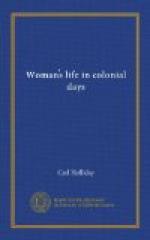We know, of course, that early in the seventeenth century schools attended by both boys and girls were established in Massachusetts, and before the Pilgrims landed at Plymouth there was at least one public school for both sexes in Virginia. But for the most part the girls of early New England appear to have gone to the “dame’s school,” taught by some spinster or poverty-stricken widow. We may again turn to Sewall’s Diary for bits of evidence concerning the schooling in the seventeenth century: “Tuesday, Oct. 16, 1688. Little Hanah going to School in the morn, being enter’d a little within the Schoolhouse Lane, is rid over by David Lopez, fell on her back, but I hope little hurt, save that her Teeth bled a Little; was much frighted; but went to School."[43] “Friday, Jan. 7th, 1686-7. This day Dame Walker is taken so ill that she sends home my Daughters, not being able to teach them."[44] “Wednesday, Jan. 19th, 1686-7. Mr. Stoughton and Dudley and Capt. Eliot and Self, go to Muddy-River to Andrew Gardner’s, where ’tis agreed that L12 only in or as Money, be levyed on the people by a Rate towards maintaining a School to teach to write and read English."[45] “Apr. 27, 1691.... This afternoon had Joseph to School to Capt. Townsend’s Mother’s, his Cousin Jane accompanying him, carried his Hornbook."[46]
And what did girls of Puritan days learn in the “dame schools”? Sewall again may enlighten us in a notation in his Diary for 1696: “Mary goes to Mrs. Thair’s to learn to Read and Knit.” More than one hundred years afterwards (1817), Abigail Adams, writing of her childhood, declared: “My early education did not partake of the abundant opportunities which the present days offer, and which even our common country schools now afford. I never was sent to any school. I was always sick. Female education, in the best families went no farther than writing and arithmetic; in some few and rare instances, music and dancing."[47]
The Dutch women of New York, famous for their skill in housekeeping, probably did not attend school, but received at home what little they knew of reading, writing, and arithmetic. Mrs. Grant, speaking of opportunities for female education in New Amsterdam in 1709, makes it clear that the training of a girl’s brain troubled no Hollander’s head. “It was at this time very difficult to procure the means of instruction in those inland districts; female education, of consequence, was conducted on a very limited scale; girls learned needlework (in which they were indeed both skilful and ingenious) from their mothers and aunts; they were taught too at that period to read, in Dutch, the Bible, and a few Calvinist tracts of the devotional kind. But in the infancy of the settlement few girls read English; when they did, they were thought accomplished; they generally spoke it, however imperfectly, and few were taught writing. This confined education precluded elegance; yet, though there was no polish, there was no vulgarity."[48]




